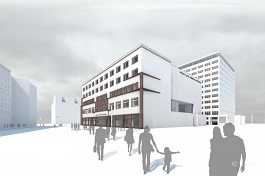
In Berlin, a museum is being established dedicated to the post-war expulsion of Germans
 |
"German society at a certain time said it wanted to have one place to remember this chapter of our history,” explains the main reason for the creation of the documentation center, Gundula Bavendamm, head of the Foundation for Flight, Expulsion, Reconciliation. As with similar historical projects, the German public debate took years. The foundation was ultimately established by the Bundestag in 2008, and construction of the museum began five years later.
Due to delays, which are not uncommon for larger projects in the German capital, the renovation of the 1920s building known as Deutschlandhaus, located near Potsdamer Platz, has significantly dragged on. The historical facade and front part of the building have been preserved, behind which a new cubic structure, the heart of the museum, has risen. The foundation will lease 6,000 square meters on three floors, which will host both permanent and thematic exhibitions, a lecture hall with a capacity of 300 people, a library, a research center, and a "room of silence" for quiet reflection on past events.
The documentation center aims to show the history of displacement and ethnic cleansing in a dual context. "On the one hand, it is about the history of forced migration in Europe in the 20th century, which is the first area, and then, of course, primarily in the context of World War II,” says Bavendamm about the expulsion of more than 12 million Germans from Central and Eastern European countries.
In the context of the first theme, the permanent exhibition will recall the disintegration of multi-national states after World War I and the associated violent population transfers, for example between Greece and Turkey, the division of British India in 1947 accompanied by massive ethnic cleansings, or wars and expulsions of populations in former Yugoslavia in the 1990s. The exhibition will also touch upon the present. However, it will not thematize migration as such, but exclusively phenomena such as expulsion, forced displacement, or deportation.
The second part of the permanent exhibition, which will have a total of 1,600 square meters, will focus on events of World War II. "The expulsion of Germans will be in the center of attention here, but in a very well-thought-out context,” emphasizes Bavendamm, who notes that the museum will also address the Nazi dictatorship and the events that led to the war, primarily from 1938 onwards.
The expulsion of roughly three million Germans from Czechoslovakia will, of course, also be thematized. The documentation center aims to present this particularly through the concrete fates of people, for instance, the stories of those who were expelled from Brno at the end of May 1945. The journey to the Austrian border, accompanied by numerous violent incidents, did not survive about 1,700 individuals.
The documentation center will illustrate the post-war period using a wide range of objects, whether they are wheelbarrows on which people transported their belongings at the time, suitcases, clothing, or letters, diaries, photo albums, maps, or newspapers. "I estimate that about 60 percent of the originals will be from our own collection and about 40 percent will be made up of loans from other collections,” says Bavendamm, noting that the foundation is regularly approached by older individuals who wish to entrust historical objects and documents to it.
Last but not least, the permanent exhibition will focus on the linguistic controversies accompanying the topic. While in Germany, the term most commonly used is "expulsion," in the Czech Republic it is referred to as "displacement," or sometimes as "wild" and subsequent "organized displacement." The Czech-German declaration from 1997 differentiates between expulsion and forced displacement.
That the exhibition may not be without controversies is evidenced by the material for the concept of the permanent exhibition, according to which the attacks against Czechoslovak Germans immediately after the end of World War II were not spontaneous, but almost always organized. In contrast, Czech historians largely consider these to be actions of a spontaneous nature.
The English translation is powered by AI tool. Switch to Czech to view the original text source.
0 comments
add comment










